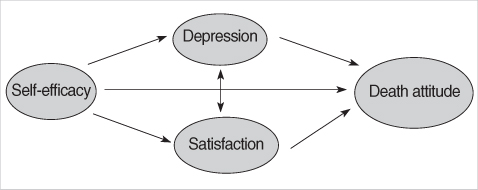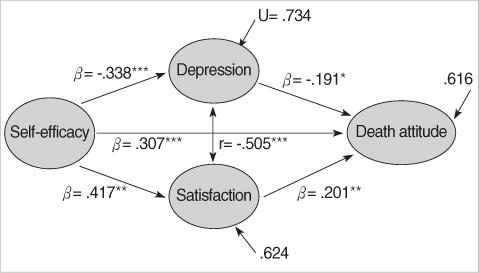J Korean Acad Nurs.
2008 Apr;38(2):229-237. 10.4040/jkan.2008.38.2.229.
Relationship between Self-efficacy, Depression, Level of Satisfaction and Death Attitude of College Students
- Affiliations
-
- 1Department of Nursing, Catholic University of Daegu, Daegu, Korea. jokw@cu.ac.kr
- 2Department of Social Welfare, Catholic University of Daegu, Daegu, Korea.
- KMID: 820076
- DOI: http://doi.org/10.4040/jkan.2008.38.2.229
Abstract
- PURPOSE: The purpose of this study was to identify the relationship among self-efficacy, depression, life satisfaction and death attitude of college students. METHODS: The subjects consisted of 232 college students. Data were collected by self-reported questionnaires, which were constructed to include self-efficacy, depression, satisfaction with life, and death attitude. Data were analyzed by the SPSS/PC WIN. 12.0 program. RESULTS: Death attitude and life satisfaction of college students were significantly different according to frequency of death ideation. Death attitude for college students correlated with self-efficacy, depression, and life satisfaction. The most significant predictor of death attitude for college students was life satisfaction. CONCLUSION: The above findings indicate that death attitude for college students is influenced by self-efficacy, depression, and life satisfaction. These findings suggest that a death education program to improve life satisfaction and to give a positive attitude toward death is needed for college students.
Keyword
MeSH Terms
Figure
Reference
-
1. American Psychiatric Association. Diagnostic and statistical manual of mental disorders. 1994. 4th ed. Washington, D.C.: American Psychiatric Association.2. Bandura A. Self-efficacy: Toward a unifying theory of behavioral change. Psychological Review. 1997. 84:191–215.3. Bohrnstedt G, Knoke D. Statistics for social dat analysis. 1994. 3th ed.Itasca, IL: F. E. Peacock Publishers.4. Burns JM, Andrews G, Szabo M. Depression in young people: what causes it and can we prevent it? The Medical Journal of Australia. 2002. 177:S93–S96.5. Cervone D, Kopp DA, Shauman L, Scott WD. Mood, self-efficacy and performance standards: Lower moods induced higher standards for performance. Journal of Personality and Social Psychology. 1994. 67:499–512.6. Chan KL, Tiwari A, Leung WC, Ho HW, Cerulli C. Common correlates of suicidal ideation and physical assult among male and female university students in Hong Kong. Violence and Victims. 2007. 22:290–303.7. Chung SK. A relational study on attitudes toward death between life satisfaction and values of juveniles. 1992. Seoul: Ewha Womens University;Unpublished master's thesis.8. Collett LJ, Lester D. The fear of death and the fear of dying. The Journal of Psychology. 1969. 72:179–181.9. Cooper J, Barnett M. Aspects of caring for dying patients which cause anxiety to first year student nurses. International Journal of Palliative Nursing. 2005. 11:423–430.10. Diener E. Subjective well-being. The science of happiness and a proposal for a national index. The American Psychologist. 2000. 55:34–43.11. Donald M, Dower J., Correa-Velez I, Jones M. Risk and protective factors for medically serious suicide attempts: a comparison of hospital-based with population-based samples of young adults. The Australian and New Zealand Journal of Psychiatry. 2006. 40:87–96.12. Hahn DW, Chon KK, Tak JK, Lee CH, Lee KH. A study on life maladjustment of college students: Based on anxiety, depression and somatization. Paper presented at the meeting of Korean Psychological Association. 1992.13. Hegel MT, Dietrich AJ, Seville JL, Jordan CB. Training residents in problem-solving treatment of depression: a pilot feasibility and impact study. Family Medicine. 2004. 36:204–208.14. Hong HY. The relationships of perfectionism, self-efficacy and depression. 1995. Seoul: Ewha Womens University;Unpublished master's thesis.15. Hong YL, Yi GE, Park HS. A structural model for health promotion and life satisfaction of college students in Korea. Journal of Korean Academy of Community Health Nursing. 2000. 11:333–346.16. Jacobs D. Suicide understanding and repondin. 1991. Madison: International University Press.17. Jo KH, Lee HJ, Lee YJ. Types of students'death attitudes majoring in human service area: Q-Methodological approach. Journal of Korean Academy of Nursing. 2005. 35:829–841.18. Kao SF, Lusk B. Attitudes of Asian and American graduate nursing students towards death and dying. International Journal of Nursing Studies. 1997. 34:438–443.19. Kim KH. Depression and suicide in Korean adolescents. Korean Journal of Psychological and Social Issues. 2004. 10:55–68.20. Kim MA, Lim SH. A Q-study on death among nursing students. Keimyung Journal of Nursing Science. 2002. 6:43–54.21. Kim MS, Lim JY. The structure of good life and the relationship with subjective well-being among college students: focusing on gender difference. The Korean Journal of Woman Psychology. 2003. 8:83–97.22. Lee HJ, Kim MH. A path model for self-identity and hopelessness to suicidal ideation of college students. Korea Journal of Youth Studies. 2007. 14:243–264.23. Lee JH. Depressive symptoms in acute and chronic schizophrenic patients. Unpublished doctoral dissertation. 1994. Seoul: Chung Ang University;Unpublished doctoral dissertation.24. Lee KH, Kim HS, Na C, Kwon HJ, Kim SH, Min BK. A study on the death awareness among health care personnels. The Official Journal of Research Institute of Medical Science of Korea. 1983. 15:174–186.25. Makaremi A. Self-efficacy and depression among Iranian college students. Psychological Reports. 2000. 86:386–388.26. Park HS, Kwon BS. Satisfaction with life and its predictors of college students. Journal of Korean Academy of Psychiatry and Mental Health Nursing. 2006. 15:48–56.27. Pyon BK, Kang SK. A study of adolescents' self-esteem and hostility. Korean Journal of Youth Studies. 2002. 9:269–291.28. Son MJ. The mechanism and the effectiveness of emotional imagery. 1984. Seoul: Korea University;Unpublished doctoral dissertation.29. Vealey RS. Conceptualization of sport-confidence and competitive orientation: Preliminary investigation and instrument development. Journal of Sport Psychology. 1986. 8:221–246.30. Zung WW, Richards CB, Short MJ. Self-rating depression scale in an outpatient clinic. Futher validation of the SDS. Archives of General Psychiatry. 1965. 13:508–515.
- Full Text Links
- Actions
-
Cited
- CITED
-
- Close
- Share
- Similar articles
-
- The Influence of Academic Self-efficacy and Major Satisfaction on Career Attitude Maturity in Nursing Students
- Effects of a Death Education Program on Life Satisfaction and Attitude toward Death in College Students
- Nursing students’ relationships among resilience, life satisfaction, psychological well-being, and attitude to death
- Comparison of Attitudes of Nursing Students toward Death, Self-esteem and Life Satisfaction according to Clinical Experience
- Relationship among Stress, Depression, and Satisfaction to Clinical Practice among Nursing Students



